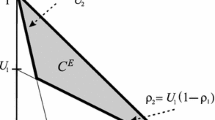Summary
This paper shows that Nash equilibria of a local-interaction game are equivalent to correlated equilibria of the underlying game.
Similar content being viewed by others
References
Anderlini, L., Antonelli, I.: Path dependence and learning from neighbours. Mimeo, Cambridge University, 1993
Aumann, R.: Subjectivity and correlation in randomized strategies. J Math Econ1: 67–96 (1974)
Blume, L. E.: The statistical mechanics of strategic interaction. Games Econ Behav5: 387–424 (1993)
Blume, L. E.: The statistical mechanics of best response strategy revision. Games Econ Behav11:111–145 (1995)
Ellison, G.: Learning, local interaction, and coordination. Econometrica61:1047–1072 (1993)
Mailath, G., Samuelson, L., Shaked, A.: Evolution and endogenous interactions. SSRI Working Paper 9426, University of Wisconsin, 1994
Author information
Authors and Affiliations
Additional information
This work was done while George Mailath and Larry Samuelson were visiting the University of Bonn, whose hospitality is gratefully acknowledged. We thank Ken Binmore for helpful discussions. This is a revision of Section 2 of Mailath, Samuelson, and Shaked [6]. Financial support from the National Science Foundation and the Deutsche Forschungsgemeinschaft, Sonderforschungsbereich 303 at the University of Bonn, is gratefully acknowledged.



